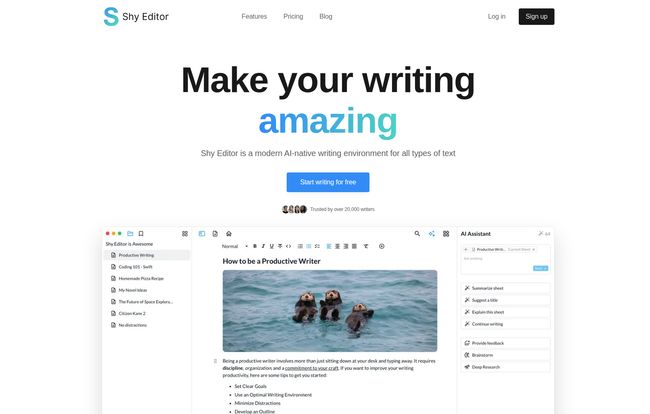The world is absolutely swimming in AI tools right now. Every other day, there's a new platform promising to “revolutionize” your workflow, write your content for you, and probably even do your taxes if you ask nicely. As someone who’s made a living with words for years, my reaction to most of these has been a healthy dose of… skepticism. I've seen too many tools that churn out robotic, soul-less text that reads like a user manual written by a committee.
The promise is always the same: efficiency. But at what cost? My creativity? My voice? No, thanks.
So, when I stumbled upon Shy Editor, the name itself made me pause. “Shy.” It doesn’t sound aggressive or revolutionary. It sounds like a quiet assistant, someone who helps from the sidelines. The homepage claims it's designed to empower writers, not replace them. Okay, you have my attention. I decided to pop the hood and see if this was just another AI gimmick or something genuinely useful for people who actually care about the craft of writing.
So, What Exactly Is Shy Editor?
At its core, Shy Editor is an online text editor and writing environment. But that's like calling a smartphone a pocket calculator. It’s built for the modern writer—and by that, they mean everyone from novelists trying to wrangle a 300-page manuscript to us bloggers trying to keep our content calendars from imploding. It’s also aimed at students, academics, journalists... basically anyone who writes for a living or for a grade.
The big hook is how it weaves artificial intelligence into the writing process. But instead of a giant “Write My Novel” button, the AI acts more like a co-pilot. It’s there to help you smooth out a clunky sentence, brainstorm ideas when you’re stuck, or check your grammar with a bit more intelligence than the squiggly red line we all know and love (and sometimes ignore).
First Impressions of the Writing Environment
The first thing I noticed upon opening the editor was the clean, minimalist interface. It’s… quiet. There aren't a million buttons and toolbars screaming for your attention. This is a huge plus for me. My brain is chaotic enough without my writing tool adding to the noise. They call it a “distraction-free environment,” and for once, the marketing speak actually holds true.
The layout feels thoughtful. On the left, a file-tree structure for organizing your project. In the middle, your blank page. On the right, a panel for notes and the AI assistant. It’s intuitive. It feels less like a piece of software and more like a tidy, well-lit digital workshop. You have your workbench (the main editor), your toolbox (the AI features), and your neatly organized shelves (the project files). It just makes sense.
The Core Features That Actually Matter
A pretty interface is nice, but it's the engine that counts. I spent some time digging into the features that would impact my day-to-day work, and a few things really stood out.
The AI Assistant: Your Friendly Neighborhood Robot
This is the main event, right? The AI. In Shy Editor, the AI is a tool you consciously choose to use. It doesn't auto-correct you into oblivion. You can highlight a passage and ask it to rephrase, shorten, expand, or change the tone. This is brilliant for those moments when you know what you want to say, but the words just aren't coming out right. It’s not writing for you; it’s helping you write better.
The intelligent grammar checker is also a step up. It catches things that standard checkers miss—awkward phrasing, redundancies, and so on. It feels more contextual, which is a big improvement.
Finally, Some Real Organization
For any large project, organization is half the battle. I’ve tried everything: a million Google Docs, folders full of .txt files, Scrivener (which is powerful but can feel like learning to fly a 747). Shy Editor strikes a fantastic balance. The file structure for chapters, notes, character sketches, and research is built right in. It’s the digital equivalent of having a beautiful binder with all your tabs perfectly labeled.
And for Pro users, there’s version control. Let me say that again for the people in the back: version control. Anyone who has ever written themselves into a corner and wished they could go back to yesterday's draft will understand why this is a godsend. It's an undo button for your entire creative process.
A Nod to the Academics and Researchers
I was pleasantly surprised to see features for bibliographies and citations. This isn't something I need every day as a blogger, but it shows a deep understanding of a specific user base. For students or non-fiction writers, being able to manage sources and citations directly within the writing app is a massive time-saver. It’s a small detail that signals serious intent.
Let's Talk Money: Shy Editor's Pricing
Alright, the all-important question: what's this going to cost me? Shy Editor uses a freemium model, which I appreciate. You can kick the tires before you buy the car.
Here’s the breakdown:
- Basic (Free): This plan is honestly pretty generous for getting started. You get unlimited projects, the basic editor features, and access to the AI assistant. The catch? You only get 20 AI credits per month and 100MB of file storage. It's enough to see if you like the workflow, but you'll hit those limits pretty quickly if you use it regularly. Export is limited to .txt, which is a bit of a bummer.
- Pro ($10/month): This is where the magic happens. For what I think is a very reasonable price, you get a massive upgrade. The AI credits jump to 500 per month, and storage increases to 5GB. You also unlock AI image generation, more export options (including the crucial PDF and DOCX formats), project version control, personalized AI styles, and priority support. Ten bucks a month is less than most streaming services, and if this tool genuinely makes your writing process smoother, that's a steal in my book.
For any serious writer, the Pro plan feels like a no-brainer. The free plan is the perfect extended trial.
Who Is This Tool Actually For?
After playing around with it, I have a pretty clear picture of who would fall in love with Shy Editor.
This is for the writer who wants a modern, clean space but is overwhelmed by the complexity of tools like Scrivener. It’s for the blogger who needs to structure their posts and get a little help polishing their prose without feeling like a machine is taking over. It’s definitely for the novelist who needs to keep track of a complex world and dozens of characters. And it's a fantastic tool for students who need to write research papers and manage their sources effectively.
Who isn't it for? If you're looking for an AI to just pump out 1,000-word articles from a single prompt, this ain't it. Shy Editor respects the writer's role too much for that. It's a collaborator, not a ghostwriter.
My Final Verdict: Should You Give Shy Editor a Try?
Yes. Absolutely. I came in skeptical, and I'm leaving impressed.
Shy Editor seems to understand what writers actually need: a quiet place to work, smart tools to help them organize their thoughts, and an intelligent assistant that offers a hand when needed, but knows when to stay out of the way. It avoids the biggest pitfall of AI writing tools by focusing on assistance, not replacement.
The Pro plan's price point is incredibly fair for the features you get, especially version control and the expanded export options. I'd recommend anyone who's even slightly intrigued to sign up for the free plan. Write a few things in it. See how it feels. It might just be the quiet, helpful partner your writing process has been missing.
Frequently Asked Questions
- Is Shy Editor completely free to use?
- Yes, there is a "Basic" plan that is free forever. It includes core writing and organizational features but has limitations on AI credits (20/month), file storage (100MB), and export formats.
- Can Shy Editor replace a tool like Scrivener or Ulysses?
- For many writers, yes. It offers the key organizational features of Scrivener (like folders for chapters, notes, and research) but with a more modern, cleaner interface and integrated AI assistance. Power users of Scrivener might miss some of its most granular features, but Shy Editor is a very strong and more user-friendly alternative.
- How do the AI credits work?
- You use an AI credit each time you ask the AI assistant to perform a task, like rephrasing a sentence, expanding a paragraph, or checking grammar. The free plan gives you 20 credits per month, while the Pro plan offers a much larger pool of 500 credits.
- What file types can I export my work to?
- The Free plan allows you to export to a plain text (.txt) file. The Pro plan adds several more crucial formats, including PDF, DOCX (for Microsoft Word), and Markdown, making it much more versatile for professional and academic work.
- Is my writing safe and private on Shy Editor?
- While you should always review the privacy policy of any online tool, platforms like Shy Editor operate on user trust. Standard industry practice is to ensure your work remains your own and is stored securely. They are not in the business of stealing your great novel idea.
- Can I use Shy Editor offline?
- Shy Editor is an online text editor, meaning you'll need an internet connection to access and use its features, especially the cloud sync and AI components. This is pretty standard for modern SaaS writing applications.




